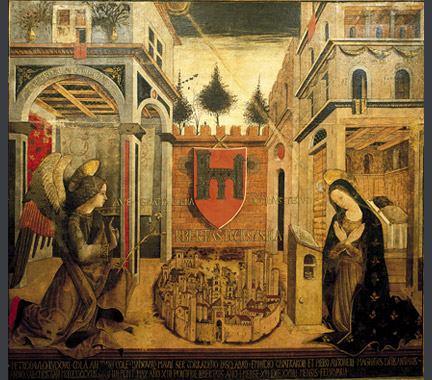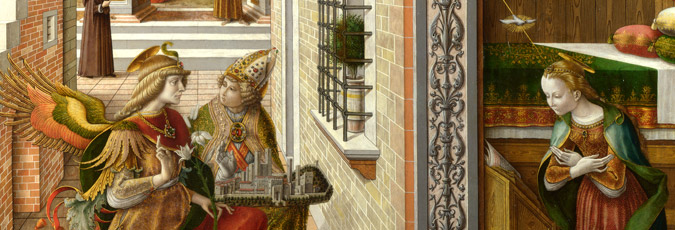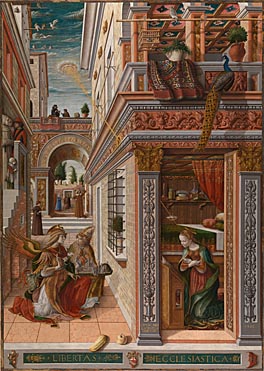Carlo Crivelli (about 1430/5–about 1494)
'The Annunciation, with Saint Emidius', 1486
Egg and oil on canvas, 207 x 146.7 cm
NG739
In 1482, Pope Sixtus IV granted the small city of Ascoli Piceno in the Marche ‘libertas ecclesiastica’, the right to self-government free from direct papal rule.1 According to contemporary accounts, the news of this important grant reached Ascoli on 25 March, the feast day of the Annunciation, a date and sacred event that thereafter assumed a central importance in the civic culture of the city. Four years later, the Venetian painter Carlo Crivelli was commissioned by the Observant Franciscan convent of the Annunziata in Ascoli to paint an altarpiece of the Annunciation celebrating the occasion. The finished painting was installed in the convent, most likely in the chapel of the Annunciate Virgin, in the same year, 1486. The civic background to this commission explains numerous unusual features within the work, specifically the urban setting, which recalls contemporary Ascoli,2 and the presence of the city’s patron saint, Emidius, who can be seen with the Archangel Gabriel offering a model of the city to its protector, the Virgin Mary.
Architectural richness
The painting itself is architecturally rich, containing a variety of buildings arranged on either side of a paved street that stretches deep into pictorial space. Most important of these is Mary’s house, which fills the entire right-hand side of the altarpiece. On the ground floor of this building, directly facing the viewer, a doorway flanked by highly ornate Corinthian pilasters offers a view into Mary’s bedroom, where she kneels reading or praying at a prie-dieu. This door also serves to frame Mary, creating the effect of an altarpiece within an altarpiece. The effect would have been heightened for a 15th-century audience by the resemblance between these pilasters and those used in contemporary altarpieces, as a comparison with the frame of Crivelli's 'Madonna della Rondine' (1490) demonstrates. Above this doorway, on the second floor of the building, there is a compact open loggia with a coffered ceiling, its arches supported on squat piers lavishly inlaid with panels of yellow marble. A rich entablature, with a frieze decorated with cornucopia-like shapes, putto masks, dolphin-handled vases and fruits,3 connects this front of the building to the more austere street façade that faces the kneeling figures of Gabriel and Saint Emidius.
The doorways and window frames on this street side are less ornate than those on the front, consisting of finely finished blocks of stone, with the small gold putti arrayed along the upper storey and the continuing entablature providing a luxurious note amidst the relative austerity. A barred window set into a thick wall emphatically divides the private, sacred space of the Virgin’s room from the street, acting also as a barrier to Gabriel’s access. The two other houses on this street are far plainer than that of the Virgin, built with more red brick than stone and lacking its ornate entablature and lavish decorative elements – a contrast that makes a pointed statement about the Virgin’s elevated status. One incongruous structure stands out from these domestic buildings – a large triumphal arch spanning the street in the middle ground.4 Faced in a yellow marble similar to that which decorates the piers of the Virgin’s upper loggia, and ornamented with a rich entablature and small classical portrait tondi (roundels), this striking arch is the only example of an apparently ‘ancient’ structure in the whole of Crivelli’s oeuvre.5
Figures interacting with buildings
A wide range of figures populate this street and interact with its buildings, whether discussing business atop the triumphal arch, or gathering in the squares that fill the background of the painting. Just across the street from the Virgin’s house a group of people stand at the top of a narrow exterior staircase, all seemingly oblivious to the seminal events unfolding before them except for a young girl, who tightly grips the balustrade in order to lean round and examine these odd visitors. The Virgin herself is firmly encased in a building, surrounded on three sides by the tight confines of her room, its privacy emphasised and secured by the barred window that faces the street. Yet the front is open to us, the viewers, who look into her private room. Mary is therefore more accessible to the beholder of the picture than to the Holy Spirit, which enters her room through a hole in the wall. The metaphorical removal of barriers between the worshipper (who through prayer before this painting becomes closer to Mary) and the Virgin is further enhanced by the extraordinary trompe l’oeil effects at the front of the pictorial space. The gourd and apple placed over the inscription blur divisions between the sacred scene envisioned in the painting, and the temporal space inhabited by the picture’s viewers.

There are many points of comparison between Crivelli’s picture and Pietro Alemanno’s Annunciation fresco of 1484, painted two years previously to commemorate Ascoli’s self-determination, which remains in the city’s Palazzo Comunale (fig. 1). Aspects of this work clearly formed the basis for Crivelli’s composition, most notably the street flanked by buildings that terminates in a high brick wall and the form of the Virgin’s house, which, as in Crivelli’s work, consists of an open room on the lower storey with a loggia above. Aside from the number and form of the buildings, the key difference between these two Annunciations lies in the placement of the figures. In Alemanno’s work Gabriel and the Virgin occupy the foreground while behind them the architecture forms a frieze-like backdrop, akin in its effect to the scenery curtain in a theatre. Crivelli, on the other hand, places his figures inside or on top of the architecture, allowing them to fully inhabit it. If Alemanno’s architecture is background, then Crivelli’s is setting in the truest sense of the term, forming a space within which the action takes place.
Davies 1947; Zanobini Leoni 1984; Zampetti 1986, p. 285; Dunkerton, Foister, Gordon and Penny 1991, pp. 344–5; Lightbown 2004, pp. 323–44.
This material was published in April 2014 to coincide with the National Gallery exhibition 'Building the Picture: Architecture in Italian Renaissance Painting'.
To cite this essay we suggest using
Alasdair Flint, ‘Carlo Crivelli, The Annunciation, with Saint Emidius’ published online 2014, in 'Building the Picture: Architecture in Italian Renaissance Painting', The National Gallery, London, http://www.nationalgallery.org.uk/research/research-resources/exhibition-catalogues/building-the-picture/entering-the-picture/crivelli-annunciation


